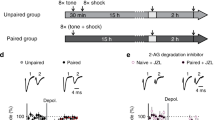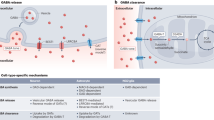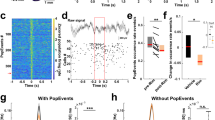Abstract
Control of pyramidal neuron excitability is vital for the functioning of the neocortex. Somatodendritic slow self-inhibition (SSI) allows inhibitory neurons to regulate their own activity, but the existence of similar mechanisms in excitatory cells has not been shown. We found that in rodents endocannabinoids mediated SSI and long-term modulation of inhibitory connections in layer 2/3 pyramidal neurons with a distinct dendritic morphology, suggesting that a glutamatergic network in cortical circuits is self-regulated.
This is a preview of subscription content, access via your institution
Access options
Subscribe to this journal
Receive 12 print issues and online access
$209.00 per year
only $17.42 per issue
Buy this article
- Purchase on Springer Link
- Instant access to full article PDF
Prices may be subject to local taxes which are calculated during checkout



Similar content being viewed by others
References
Carandini, M. & Ferster, D. Science 276, 949–952 (1997).
Bacci, A., Huguenard, J.R. & Prince, D.A. Nature 431, 312–316 (2004).
Marinelli, S. et al. J. Neurosci. 28, 13532–13541 (2008).
Trettel, J., Fortin, D.A. & Levine, E.S. J. Physiol. (Lond.) 556, 95–107 (2004).
Chevaleyre, V., Takahashi, K.A. & Castillo, P.E. Annu. Rev. Neurosci. 29, 37–76 (2006).
Kano, M., Ohno-Shosaku, T., Hashimotodani, Y., Uchigashima, M. & Watanabe, M. Physiol. Rev. 89, 309–380 (2009).
Hill, E.L. et al. J. Neurophysiol. 97, 2580–2589 (2007).
Fortin, D.A. & Levine, E.S. Cereb. Cortex 17, 163–174 (2007).
Stella, N., Schweitzer, P. & Piomelli, D. Nature 388, 773–778 (1997).
Hashimotodani, Y., Ohno-Shosaku, T., Maejima, T., Fukami, K. & Kano, M. Neuropharmacology 54, 58–67 (2008).
Spruston, N. Nat. Rev. Neurosci. 9, 206–221 (2008).
Watanabe, M. et al. Eur. J. Neurosci. 10, 478–487 (1998).
Freund, T.F., Katona, I. & Piomelli, D. Physiol. Rev. 83, 1017–1066 (2003).
Leff, P. Trends Pharmacol. Sci. 16, 89–97 (1995).
Kellogg, R., Mackie, K. & Straiker, A. J. Neurophysiol. 102, 1160–1171 (2009).
Acknowledgements
We thank N. Berretta (Fondazione Santa Lucia) for insightful discussion, and P. Mendez-Garcia (European Brain Research Institute) and J. Lourenço (INSERM) for critically reading the manuscript. We are grateful to M. Ammassari-Teule (CNR–Institute of Neuroscience and Fondazione Santa Lucia) for the use of Neurolucida, and to M. Watanabe (Hokkaido University School of Medicine) for the gift of CB1 antibody. This work was supported by the Giovanni Armenise-Harvard Foundation (Career Development Award to A.B.), the European Commission (a Marie Curie International Reintegration Grant to A.B.), the European Research Council (ERC) under the European Community's 7th Framework Programme (FP7/2007-2013, ERC grant agreement number 200808, A.B.), the Italian Institute of Technology (A.B.), Avenir INSERM (in partnership with the Fondation Bettencourt-Schueller, G.M.), Agence National de la Rechereche (G.M.), Region Aquitaine (G.M.), the European Commission Coordination Action ENINET (contract number LSHM-CT-2005-19063 to A.B. and G.M.). A.B. is the 2007/2008 National Alliance for Research on Schizophrenia and Depression Henry and William Test Investigator.
Author information
Authors and Affiliations
Contributions
S.M. and A.B. designed the experiments, S.M. conducted all of the electrophysiological experiments, and S.P. performed the immunhistochemistry and morphological analyses. S.M., S.P. and A.B. analyzed the data. A.C. and G.M. performed the in situ hybridization and provided the mutant mice. S.M., G.M. and A.B. wrote the manuscript.
Corresponding author
Supplementary information
Supplementary Text and Figures
Supplementary Figures 1–4, Supplementary Tables 1, 2 and Supplementary Methods (PDF 3289 kb)
Rights and permissions
About this article
Cite this article
Marinelli, S., Pacioni, S., Cannich, A. et al. Self-modulation of neocortical pyramidal neurons by endocannabinoids. Nat Neurosci 12, 1488–1490 (2009). https://doi.org/10.1038/nn.2430
Received:
Accepted:
Published:
Issue Date:
DOI: https://doi.org/10.1038/nn.2430
This article is cited by
-
Endocannabinoids at the synapse and beyond: implications for neuropsychiatric disease pathophysiology and treatment
Neuropsychopharmacology (2023)
-
Targeting the endocannabinoid system: a predictive, preventive, and personalized medicine-directed approach to the management of brain pathologies
EPMA Journal (2020)
-
Cannabinoids, TRPV and nitric oxide: the three ring circus of neuronal excitability
Brain Structure and Function (2020)
-
Integrating endocannabinoid signaling in the regulation of anxiety and depression
Acta Pharmacologica Sinica (2019)
-
Multiple endocannabinoid-mediated mechanisms in the regulation of energy homeostasis in brain and peripheral tissues
Cellular and Molecular Life Sciences (2019)



